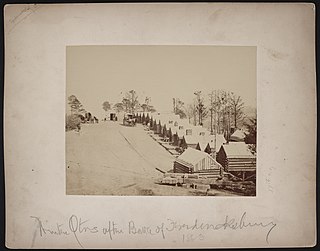This article has multiple issues. Please help improve it or discuss these issues on the talk page . (Learn how and when to remove these template messages)
|

The Forest City Stockade was built in central Minnesota to defend settlers in the area from Indian attacks. It became famous during the Dakota War of 1862. Today, visitors to the site can visit a rebuilt stockade and see volunteers in 1800-style dress illustrate period life and activities. A threshing bee takes place across the road in August. The site of the stockade is between Litchfield and Forest City near Minnesota State Highway 24. [1]
The following is a list of those who defended the Forest City Stockade in September 1862 who were mustered in on August 24, 1862 (names noted w/*) and known as the 'Meeker County Volunteers' by August 28, 1862. G. C. Whitcomb claimed to be captain of the group by the captains commission issued by Colonel H. H. Sibley to send 75 Springfield muskets with him (31 were dropped off in Hutchinson, who too were in dire need.)
- ANGIER, HENDERSON M
- ATKINSON, J. B. - Sheriff & County Commissioner - never left Forest City -Elected 1st Lieutenant
- BEHRMANN, H.
- BRADSHAW, J. H.
- BRANHAM, JESSIE V. JR - suggested Forest City stockade construction - scout with Captain Strout was wounded near Acton on September 3
- BRANHAM, JESSIE V. SR. - rode 100 miles to get military aid in Sioux uprising.
- BRANHAM, WILLIAM H/A - elected 1st Sergeant - had guard duty night of attack - wounded during counterattack on Forest City
- CASWELL, WILLIAM
- CHAPIN, D.
- CHAPIN, E. A. - county commissioner
- COBB, JESSE F. - forage detail
- CONDON, PATRICK
- DANIELSON, NELS - wounded - secured north side during attack
- DART, CHANCEY - guard duty the night of attack and gave warning shot
- DOUGHERTY, THOMAS
- GARRISON, J. B.
- GIBBONS, ELI
- GIBBONS, OLIVER - forage detail
- GORTON, MILTON - never left Forest City
- GOULD, FREEMAN L/G - elected 4th Sergeant
- GRAYSON, THOMAS - never left Forest City
- HAMILTON, ANDREW
- HANSON, PETER E
- HARVEY, JAMES M - county auditor - never left Forest City - Elected 5th Sergeant - Quarter Master Commission on August 28 - hero during Indian outbreak
- HEATH, A. F. - elected 1st Corporal
- HEATH, J.
- HILL, H. J. - elected 2nd Corporal
- HOLBROOK, D. M.
- HOWE, H. S. - elected 2nd Sergeant
- HOYT, AZRO B/ALONZ B - elected 8th Sergeant
- HUTCHINS, SAMUEL - elected 4th Corporal
- JEWETT, T C (Carlos/Charles) - Register of Deeds - never Left Forest City - elected 3rd Corporal
- JOHNSON, HENRY
- JOHNSON, W.
- KRUGER, CHARLES
- KRUGER, HERMAN
- LANG, JAMES B.
- LARSON, ANDREW
- LUTONS, H.
- MAYBEE, CHARLES D.
- MCGRAW, CORNELIUS
- MCGRAW, DANIEL - elected 3rd Sergeant
- MCGRAW, MICHAEL (JR)
- MERRILL, M. D./NEHEMIAH D.
- MICKELSON, HOVER
- MORRILL, N. D. (NEHEMIAH)
- MOUSLEY, ALFRED
- NELSON, ANDREW - guard duty the night of attack
- NELSON, JAMES H.
- OLSON, ASLOG - secured north side of stockade during attack - wounded during counterattack
- OLSON, HALGA(R)
- PAGE, GEO. R.
- PAYSON, C. E.
- RAGAN, THOMAS
- RALSTON, R. B. - elected 6th Corporal
- REEF, EMANUEL M - (Gottlip?) - provisions guard
- ROGERS, JEROME
- SCHULTZ, RUDOLPH
- SHOLES, GEORGE S, SR - never left Forest City
- SKINNER, THOMAS H - never left Forest City
- SMITH, ABNER COMSTOCK - Judge of Probate - never left Forest City
- SMITH, HENRY L - never Left Forest City - guard duty the night of attack - fired first return shot at the Indians
- SMITH, LORY (Louis?)
- SPERRY, ALBERT C
- STANTON, JUDSON A - Clerk Of Court - never Left Forest City - forage detail
- STEVENS, HAMLET - never Left Forest City - elected 2nd Lieutenant - guard duty the night of attack and gave warning shot
- STEVENS, SYLVESTER - never Left Forest City - guard duty the night of attack
- SWOUTART, E.
- THOMAS, JOSEPH C.
- TODD, O. B.
- TORNBORN, NELS
- TOWLER, WM - never left Forest City - provisions guard
- WAGGONER, G W
- WHITCOMB, GEORGE C - Treasurer of Meeker Co. 1862, rode from Forest City stockade to Carver & took a boat to St Paul to sound the
alarm of the attack Aug 22-3, before Jessie Branham did the same thing.
- WHITE, N. H. - elected 7th Sergeant
- WHITE, S. W.
- WILCOX, WILLIAM H











